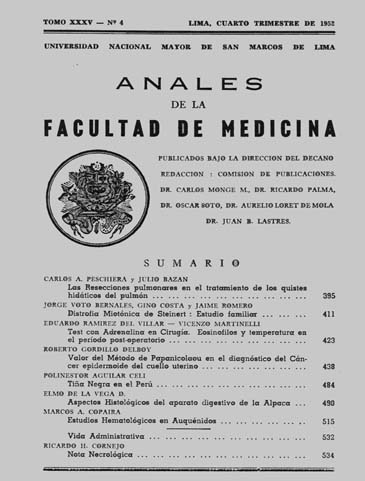Papanicolaou method value in the diagnosis of squamous cell carcinoma of the cervix
DOI:
https://doi.org/10.15381/anales.v35i4.9419Abstract
We studied 482 patients from the outpatient clinic of Gynecology Hospital Loayza Archbishop of Lima, selected by age and certain gynecological conditions. Taking secretions were the posterior fornix of the vagina. 11.4% of patients have a residence of less than six months in Lima. Average age: 45.3 years and between 30 and 60 years. There is sufficient information to link race and pregnancy status to the incidence of cancer. In diseased with cancer presented functional disorders usually associated. In the 482 patients selected, there are 50 cases of cancer confirmed by biopsy. Diagnosed clinically, 14. suspected and diagnosed as cervicitis, 36 No clinically suspected and diagnosed incidentally. The result of the examination of the sheets was as follows: Fixed: 460 cases. Positive, Negative 40, 420 Wrong: "False positives", 12 "False negatives" Approach 10: 95.4%. Error: 4.6%. Coincidentally and without the slightest accused clinical symptoms were diagnosed by Papanicolaou method 1 case of invasive carcinoma Pre Neck, 2% of all cancers. No cases have been found Cervical Adenocarcinoma. There is a case of Endometrial Adenocarcinoma and an error of 50% in the diagnosis of this type of uterine cancer. In the Pre-invasive carcinoma of cervix differentiated malignant cells which the authors correspond to the less malignant forms of cancer were found. In this regard, we judge that very book should be considered the value of the Papanicolaou method in determining the degree of malignancy of a tumor by the lack of correlation between clinical malignancy and appreciated histologically or cytologically malignant. Since morphologically malignant undifferentiated and differentiated cells are described. In cases of undifferentiated malignant cells are described and shown hyperchromatism phenomena, chromatin condensation, changes in size, phenomena of phagocytosis, etc. "Fiber Cells" form type "tadpole" and the so-called "third kind" Graham classification: the three differentiated cell types are considered. The "false positive" cases were due to a misunderstanding of the cellular elements. The confusion came from endometrial cells with signs of degeneration, aberrant cells from the outer basal fanciful shapes, type cervical cells with various phenomena of degeneration, benign cells from the inner basal with delicate chromatin and large nucleus, cells from equally baseline who experienced nuclear changes due to infection or trichomoniasis, endocervical cells and certain types of histiocytes. There are 10 "false negative" cases. Endometrial Adenocarcinoma, Squamous Neck Cancer what, 9 cases. The sources of error are due to improper technique in making samples, insufficient number of sheets prepared in each case, precipitation in the reading of the slides, lack of knowledge of the patient's condition and the personal factor.Downloads
Published
1952-12-31
Issue
Section
Trabajos originales
License
Copyright (c) 1952 Roberto Gordillo Delboy

This work is licensed under a Creative Commons Attribution-NonCommercial-ShareAlike 4.0 International License.
Those authors who have publications with this magazine accept the following terms:
- Authors will retain their copyrights and guarantee the journal the right of first publication of their work, which will be simultaneously subject to Creative Commons Attribution License that allows third parties to share the work as long as its author and its first publication this magazine are indicated.
- Authors may adopt other non-exclusive licensing agreements for the distribution of the version of the published work (eg, deposit it in an institutional electronic file or publish it in a monographic volume) provided that the initial publication in this magazine is indicated.
- Authors are allowed and recommended to disseminate their work over the Internet (eg: in institutional telematic archives or on their website) before and during the submission process, which It can produce interesting exchanges and increase quotes from the published work. (See El efecto del acceso abierto ).
How to Cite
1.
Gordillo Delboy R. Papanicolaou method value in the diagnosis of squamous cell carcinoma of the cervix. An Fac med [Internet]. 1952 Dec. 31 [cited 2025 Jun. 19];35(4):438-83. Available from: https://revistasinvestigacion.unmsm.edu.pe/index.php/anales/article/view/9419



